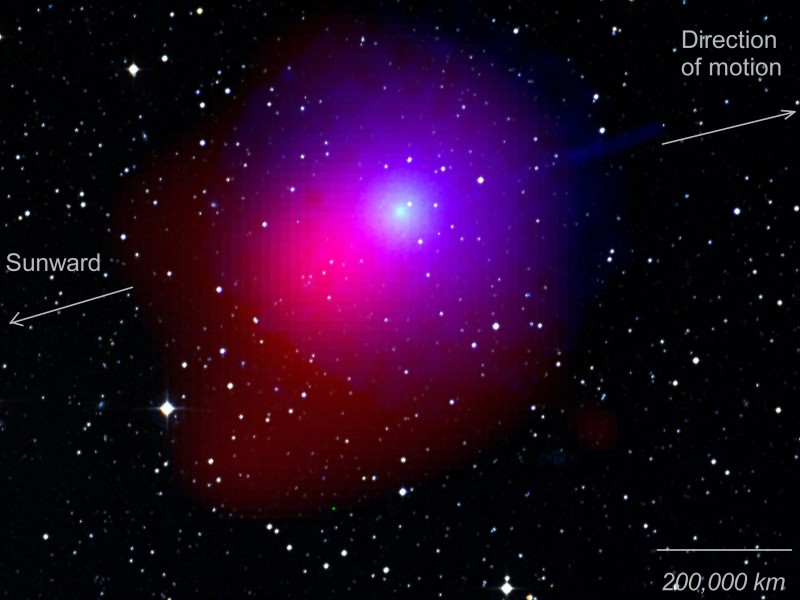Credit & Copyright: NASA,
Swift,
Univ.
Leicester,
DSS (STScI/AURUA),
Dennis Bodewits (NASA/GSFC), et al.
Explanation:
Now growing brighter, Comet Lulin is headed for its
closest approach to planet Earth early next week.
But the comet's greenish glow,
familiar to
earthbound skygazers, is replaced
by false colors in
this
premier view from the
orbiting
Swift
satellite.
Image data from the Swift detectors, normally intended to
follow cosmic
gamma-ray bursts, were recorded on January 28.
The data are
combined here, along with a sky survey image of background stars,
to show optical and ultraviolet light in green-blue hues
and x-rays from the comet in red.
The result maps remarkable
x-ray emission on the comet's sunward
side as incoming solar wind ions interact
with gases in the swollen
coma.
It also shows substantial ultraviolet emission opposite the Sun,
in the direction of motion and the comet's tail.
The ultraviolet emission is from the OH molecule derived
from the breakup of water, an indicator of the copius amounts of water
produced by this extremely
active comet.
In fact, astronomers estimate Lulin was releasing about
800 gallons of water each second, enough to fill an Olympic-size
swimming pool in less than 15 minutes.
Dennis Bodewits (NASA/GSFC), et al.
1999 2000 2001 2002 2003 2004 2005 2006 2007 2008 2009 2010 2011 2012 2013 2014 2015 2016 2017 2018 2019 2020 2021 2022 2023 2024 2025 |
Yanvar' Fevral' Mart Aprel' Mai Iyun' Iyul' Avgust Sentyabr' Oktyabr' Noyabr' Dekabr' |
NASA Web Site Statements, Warnings, and Disclaimers
NASA Official: Jay Norris. Specific rights apply.
A service of: LHEA at NASA / GSFC
& Michigan Tech. U.
|
Publikacii s klyuchevymi slovami:
comet Lulin - c/2007 n3 - Coma - ultraviolet - water - komety - koma
Publikacii so slovami: comet Lulin - c/2007 n3 - Coma - ultraviolet - water - komety - koma | |
Sm. takzhe:
Vse publikacii na tu zhe temu >> | |
